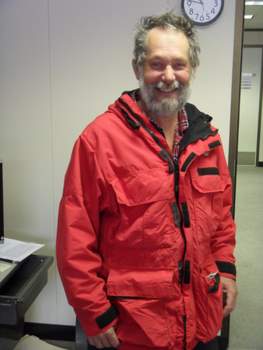Maurice (pronounced "Morris") Conway is the mountaineer for our team. Any scientific research expedition that ventures into the "Deep Field" (any area beyond McMurdo and associated hub-fieldcamps - like the Central TransAntarctic Mountains - CTAM) must have a mountaineer accompany them. This is to insure their safety in the field. Before going out into the field, Maurice's job is to make sure all the equipment that is necessary for safety is gathered and is all in good shape or functioning properly. While in the field, Maurice insures that camp is secure (all items properly tied down so they don't blow away, not set up in a dangerous area - i.e. over a crevasse on a glacier, etc.). He also assists with glacier travel such as making sure everyone has their harnesses on properly, knots are tied correctly, crampons are fitted and secure, and ice axe techniques are well understood (self-arrest procedures, testing for crevasses, etc.). Maurice's skills as a paramedic will come in very useful should a medical emergency arise. Another of his tasks in camp is as "Chief Pizza Maker". Every Saturday night, Maurice traditionally bakes pizzas in a Coleman oven on the stove. I came down here, expecting more traditional camping fare, so this was a real treat!

In addition to keeping all of us safe, he also assists the scientists. The expedition he was on prior to ours was with his brother, Howard "Twit" Conway, who is also on our expedition. On that project, they were at Roosevelt Island (in the Ross Sea, locked in the Ross Ice Shelf). There, they were pulling radar equipment behind snowmachines on a series of grid transects to determine the depth of the ice shelf. During our expedition, Maurice will again be assisting Twit. This time they will be flying in a Twin OtterA highly maneuverable utility aircraft developed by de Havilland Canada. It can be flown slowly and in tight circles, and is designed for 20 passengers, short takeoffs and landings, and often used for cargo, passengers, and as a science platform. aircraft with radar conducting surveys over the Shackleton, Scott, and Beardmore Glaciers. Once they have completed this task, they will join us in our next camp on Mt. Kyffin.
Maurice first came to Antarctica in 1979 in the capacity of mountaineer for a German geological expedition. They sailed to Antarctica on a German research vessel; the voyage took them five days. Once was enough for him to be hooked; he said he knew he had to return because it was so "awe inspiring". For the next eleven seasons (a season is the austral summer), he continued to return with the same German scientists. For the other seasons, he has contracted as a mountaineer for other scientific groups funded by the United States National Science Foundation (NSF). Maurice has 25 seasons of experience under his belt; he has only missed a few seasons working in Antarctica.

He says the things he enjoys the most about coming to Antarctica is the scenery, the comraderie with scientists and support staff who have become close friends, and the quality time he can spend with his brother, Twit. He hopes to continue working here until he can no longer pass the physical qualifications required by NSF. Maurice truly loves what he does down here; to him, it's like a "paid holiday".
He began his adventures when his father took him on his first mountaineering trip when he was twelve. They ascended an 8,000+ ft. volcano on New Zealand's north island. It had a ice summit which required crampons, an ice axe, and being roped up. Because of that trip, he fell in love with mountains and knew he had to find a way to get paid to do this kind of work. During the austral winter (our summer) when it is dark 24 hours/day in Antarctica, Maurice is an EMT in Thames, New Zealand. He has two sons, both of which share some of his love of being outdoors and climbing. His oldest son has just received his geology degree and is working in North America; his second son is an arborist.
Maurice is a fun person to be around and his experience truly makes me feel safe in this potentially threatening, beautiful land. I'm so very glad to have met him and to have him along on my expedition.


Comments